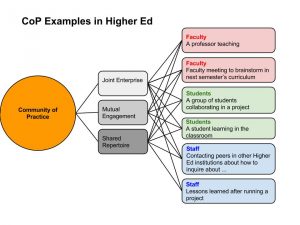Chapter 2 of Wenger’s book discusses “Community of Practice”. As definition, a Community of Practice (CoP) is a learning partnership where people engage in such partnership and start creating a learning environment by sharing common interests and needs with a set of tools. This correlates directly to one of the classes themes, Community, and certainly indirectly to the other two themes, Identity and Design. Wenger, a Social Learning Theorist, discusses the different dimensions of practice that embody community of practice; mutual engagement (identity), a joint enterprise (identity, design), and a shared repertoire (design).
The author goes in detail about how a CoP gets created, what are the necessary components, ground rules, its resources, governance, etc. Conditions, resources, and demands shape the practice.
A CoP does not necessarily need to be “healthy”, meaning, there will be fighting, disconnects, arguments, but at the end, it will still be a community of different and diverse personalities, learning and sharing valuable content.
I found this not to be an easy read. I complemented the reading with other articles from the web, as well as a few videos in YouTube. Time permitting, I will read chapter 1, as there were a few references in chapter 2 to this chapter.
Here are a few examples of a CoP in the Higher Ed space:
The questions I’d like to pose;

I felt the same way Shady. This reading was not easy for me to understand either. I think the visual in your post really clears things up. Great job!
I like the chart with concrete examples – helps me to put the theory in context. Thanks!